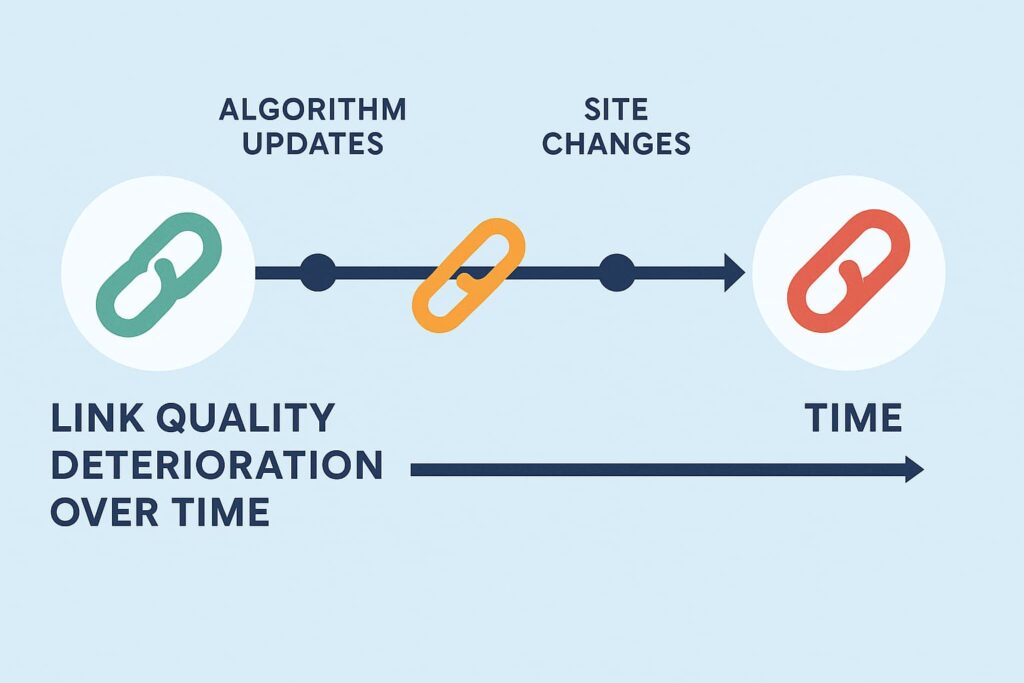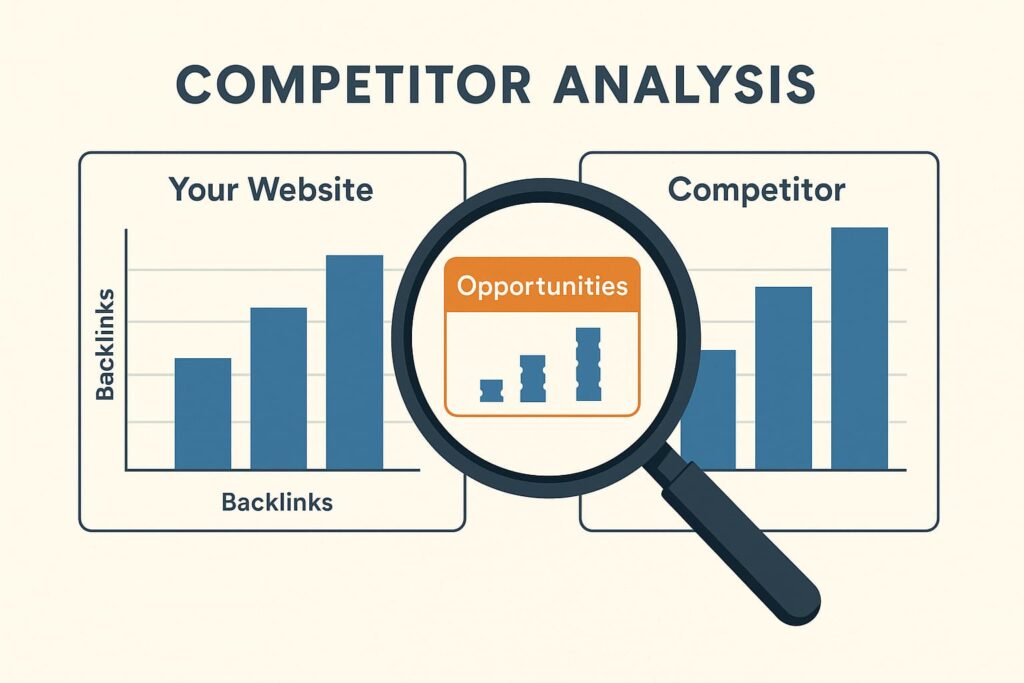Running a link audit once a year is a smart move for anyone serious about SEO. Even solid backlink profiles can pick up bad, outdated, or low-quality links that hurt performance over time. A yearly check helps catch those issues early, protect your rankings, and improve future outreach. Instead of waiting for traffic to slip, experienced marketers make audits part of their regular routine.
Why Link Quality Changes Over Time
A backlink profile is never static — what was once an asset can quickly become a liability. Even if your links were perfectly healthy last year, they may be harming your rankings today. There are four primary reasons why link quality deteriorates over time:
1. Websites Change Ownership or Go Offline
The internet is constantly shifting. A reputable industry blog that linked to you last year might have been sold and turned into a low-quality private blog network (PBN). These PBN links, which were once valuable, can now trigger Google penalties.
Furthermore, websites shut down every day. When a domain expires or a firm goes out of business, all of the links to your site are broken. Even if the material remains active, pages are removed via site redesigns or content pruning, causing you to lose legitimate backlinks.
2. Google’s Algorithm Updates Change the Rules
SEO best practices from five years ago can be dangerous today. Tactics that once worked — like exact-match anchor text over-optimization or directory link building — are now red flags that can hurt your rankings.
Google’s algorithms also regularly reassess website authority. A site that passed strong link equity in the past might be devalued after an algorithm update. This means links from that domain no longer benefit your SEO, and in some cases, may actually harm it.
3. Competitors Are Always Evolving Their Strategies
While you focus on other marketing tasks, your competitors are actively working to improve their backlink profiles. They’re getting featured on industry blogs you may have missed, securing mentions in news articles, and forming partnerships that generate valuable links.
There’s also a risk of negative SEO attacks. Some unethical competitors may try to harm your rankings by creating spammy links to your site from questionable sources like gambling or adult websites. These violate Google’s guidelines and could hurt your rankings if not addressed.
In summary, you cannot afford to overlook your backlink profile while rivals continue to enhance theirs.
4. Your Own Website Changes Impact Backlinks

Common site updates often unintentionally damage your backlink profile. Migrating to a new domain or changing URL structures without proper 301 redirects breaks existing links. Content removals — whether deleting old blog posts or discontinued product pages — cause you to lose legitimate backlinks permanently.
Even beneficial modifications, such as site redesigns, might be troublesome if they modify navigation systems or eliminate pages with established backlinks. Without careful preparation, these enhancements might unintentionally undo years of link-building effort.
Top 5 Signs Your Site Needs an Audit
Regular link audits allow you to spot issues before they impact your search rankings. If you see any of the following warning signs, check your backlinks right away:
1. Unexplained Ranking Drops Across Multiple Keywords
When your pages suddenly lose positions without any clear content or technical issues, your backlink profile is often the culprit. Google may have:
- Detected and devalued spammy or artificial links.
- Identified an unnatural anchor text distribution pattern.
- Applied algorithmic penalties due to low-quality referring domains.
This is particularly urgent if the drops affect your most valuable commercial keywords, as recovery can take months without prompt action.
2. No Recent Backlink Analysis (12+ Months Since Last Audit)
If you haven’t audited your backlinks in over a year, you risk overlooking serious issues—even if your rankings haven’t dropped yet. Over time, 15-20% of your backlinks can become toxic as spam sites appear or legitimate sites get penalized. You also lose valuable links when websites delete content or shut down. Meanwhile, your anchor text ratios may shift toward unnatural patterns without you noticing.
These problems don’t always cause immediate ranking declines, so they’re easy to miss. A yearly audit helps catch them early, before they hurt your SEO. Just as you wouldn’t ignore warning signs in business metrics, you shouldn’t wait for rankings to crash before reviewing your backlinks. Regular checks let you fix issues proactively.
3. Competitors Outperforming You With Inferior Content
When nearly identical content ranks higher on competitor sites, their backlink profile advantages typically explain the disparity. They may have:
- More authoritative referring domains (especially .edu/.gov links);
- Better link diversity across industry sources;
- Stronger editorial placements in trade publications;
- Fewer toxic links dragging down their domain authority.
A competitive link gap analysis reveals exactly where you’re falling behind.
4. Google Search Console Manual Actions Notification
A manual actions notification in Google Search Console is direct confirmation that Google has reviewed and penalized your backlink profile. This alert means Google’s human reviewers — not just algorithms — have examined your links and found clear violations of their Webmaster Guidelines. The notification will specifically state whether you’ve received a “thin links” penalty (for low-value backlinks) or an “unnatural links” penalty (for manipulative link schemes).
Unlike algorithmic ranking drops, manual penalties won’t go away on their own—they require manual cleanup. You’ll need to audit your backlink profile, submit a reconsideration request with supporting documentation, and wait for Google’s review. The type of penalty shapes the response: thin links may need content fixes and pruning, while unnatural links often require disavowing and removal. Ignoring these issues leads to lasting ranking losses.
5. Run a Link Audit Before Starting an SEO Campaign
Starting new content or link-building work without reviewing your current backlinks can lead to problems. A pre-campaign audit:
- Removes toxic links that could undermine new efforts
- Identifies your strongest assets to amplify
- Reveals which link types will be most effective
- Prevents mixing new high-quality links with existing problematic ones
When to Act: If you’re experiencing even one of these warning signs, delaying an audit risks compounding the damage. The most successful websites treat link audits as preventive maintenance rather than emergency repairs. For sites seeing multiple warning signs, the audit should include a comprehensive disavow file analysis and competitor benchmarking to fully diagnose issues.
Tools and Methods for Conducting an Audit
A thorough backlink audit requires the use of appropriate tools and a methodical strategy. While automatic scans can detect apparent flaws, a full assessment requires manual verification to assure accuracy. Here’s how to do a full audit:
Step 1: Pull Your Backlink Data
Start by gathering data from multiple sources to get a complete picture of your backlink profile. Ahrefs and SEMrush are excellent for identifying active links, while Google Search Console reveals which backlinks Google actually recognizes. Majestic provides valuable historical link data, helping track changes over time. Using multiple tools ensures you don’t miss any important links.
Step 2: Filter Out Noise
Once you have your raw backlink data, clean it up by removing duplicate entries and irrelevant links. Internal links (those from your own domain) don’t count as backlinks and should be excluded. Also, filter out links from other domains you own, as these can skew your analysis.
Step 3: Categorize Links by Quality
Not all backlinks are equal. Separate them into three groups: high-quality links to keep (from authoritative, relevant sites), low-quality links to monitor (not harmful but not valuable), and toxic links to remove or disavow (from spammy or irrelevant sources). This classification helps prioritize your cleanup efforts.
Step 4: Compare Against Competitors
Use tools like Ahrefs’ Link Intersect to analyze competitors’ backlink profiles. This reveals which high-quality sites are linking to them but not to you, identifying potential outreach opportunities. Understanding these gaps helps refine your link-building strategy.
For businesses that want a hands-off approach, services like 3XE Digital offer full audits—including competitor gap analysis, toxic link removal, and a clear recovery plan. Their team manually checks each link, avoiding the false positives that automated tools sometimes generate.
Disavowing Harmful Links the Right Way
A clean backlink profile is essential for SEO success, and knowing how to properly disavow toxic links is key. While Google’s disavow tool is effective for removing harmful links that could hurt your rankings, it should be used strategically—misuse might accidentally block links that actually help your site.
When Disavowing is Necessary
The disavow tool should primarily be used for three types of harmful links:
- Spammy domains – Gambling, adult, payday loan, or PBN sites (violate Google’s guidelines).
- Artificial links – Paid placements, sponsored posts without nofollow, or manipulative guest posts (risky even if they once helped rankings).
- Unnatural anchors – Over-optimized or irrelevant anchor text (e.g., a plumbing site linked with “best smartphones”).
The Safe Disavowal Process
To properly disavow links without causing collateral damage:
- First, export all suspicious links identified during your link audits and attempt manual removal by contacting webmasters. Many site owners will comply with removal requests, especially for obviously spammy links.
- For links that cannot be removed after multiple attempts (or where the webmaster is unresponsive), create a disavow file following Google’s exact formatting requirements.
- Submit the disavow file through Google Search Console. It’s critical to only include truly harmful links – disavowing good links can strip away hard-earned ranking power.
- Monitor your rankings and Search Console messages for several weeks after submission. In some cases, you may need to submit a reconsideration request if you’re recovering from a manual penalty.
Important Considerations
Avoid disavowing large portions of your backlink profile without a careful review. Update your disavow file regularly when new harmful links appear. The disavow tool is meant to prevent future issues, not to recover rankings already lost. If you’re not sure whether a link should be disavowed, consult with an SEO professional.
Disavowing alone is not enough. An effective backlink strategy should include targeted disavows, ongoing link building, and regular monitoring to maintain link quality.
Reclaiming Lost Backlinks and Missed Opportunities

One of the most valuable yet often overlooked aspects of link auditing is identifying and recovering lost backlinks while uncovering new linking opportunities from competitor analysis.
Recovering Broken Backlinks
When high-quality websites link to your content but those links become broken (typically returning 404 errors), you’re losing valuable link equity. Tools like Ahrefs’ Broken Backlinks report help identify:
- Specific pages that previously linked to your site but no longer exist;
- The authority and relevance of the linking domains;
- Whether the links pointed to content you still maintain.
To reclaim these lost links:
- For content that still exists but has moved, implement 301 redirects from old URLs.
- If the linking site removed their content linking to you, reach out to suggest alternative pages of yours they could reference.
- For your own deleted content, consider restoring valuable pages that earned links.
Leveraging Competitor Backlinks
Analyzing where competitors get their links reveals untapped opportunities:
- Industry blogs linking to competitors may accept your content if you offer more comprehensive or updated information.
- Local directories and business listings where competitors appear should include your business as well.
- News sites that featured competitors might cover your company if you develop newsworthy angles.
- Resource pages linking to competitors could be persuaded to add your content if it provides additional value.
The key is not just copying competitor links, but improving upon them — offering better content, more complete resources, or more timely information. This strategic approach to reclaiming lost links and capitalizing on competitor gaps can significantly strengthen your backlink profile without requiring entirely new outreach efforts.
Implementation Tips
Start by reclaiming links from high-authority sites—they deliver the biggest SEO boost. When reaching out to webmasters, highlight how your content benefits their readers. Track recovered links to measure ranking impact, and monitor regularly for new broken links and competitor opportunities. This proactive approach maximizes recovered equity and strengthens your backlink profile over time.
Using Audit Insights for Smarter Outreach
Your link audit findings should directly inform your link-building strategy. Focus first on replicating what worked best — prioritize acquiring more links from the high-authority sites in your niche that already link to you. Before pursuing new links, eliminate any toxic ones that could undermine your efforts. Identify key gaps in your profile compared to competitors, such as significantly fewer .edu links, and make these a priority.
Finally, balance your anchor text distribution by removing over-optimized exact-match terms with more natural, branded alternatives. This tailored strategy guarantees that your outreach activities have optimum impact.
Conclusion
Annual link audits are required to maintain SEO performance since backlink profiles decline over time as a result of algorithm upgrades, competition actions, and site modifications. Proactive audits may help you eliminate toxic links, recover missed opportunities, detect competition advantages, and direct wiser outreach, transforming your backlinks into a growing asset rather than a burden. Making audits a yearly priority ensures that your link-building efforts continue to boost rankings and organic development.




